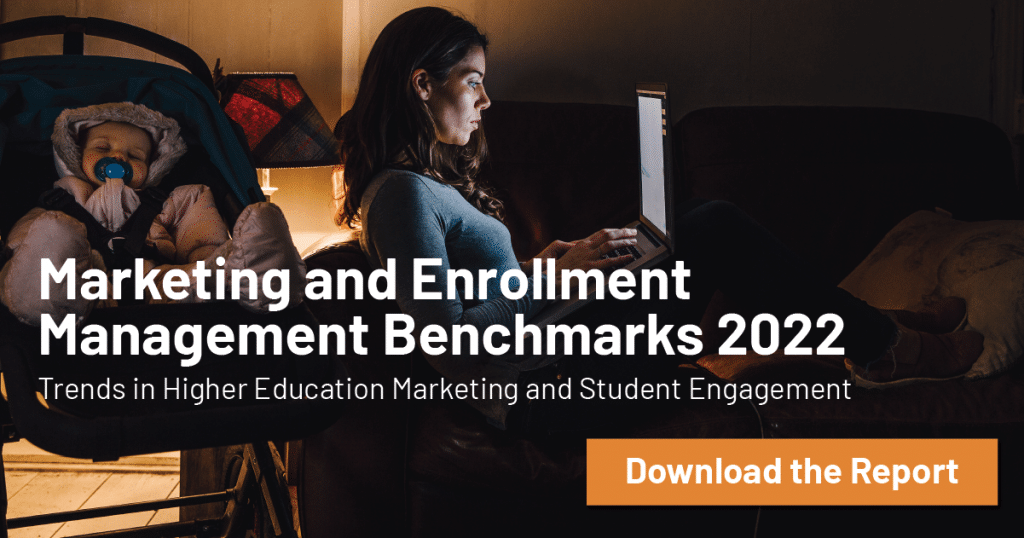Marketing & Enrollment Management Benchmarks 2022

Trends in Higher Ed Marketing and Student Engagement for 2022
Over the last year, education has undergone a transformation. Some of the changes that first seemed like temporary adjustments to accommodate the pressures of a pandemic have become permanent fixtures of the education landscape. Most universally, this year confirmed the demand for flexibility in higher education. Our 2022 Marketing and Enrollment Management Benchmarks Report makes clear the staggering shifts that have happened in adult and online higher education marketing and enrollment management.
Forward-thinking colleges and universities have realized that old assumptions no longer apply. The needs of students have changed — are still changing — and online and non-traditional programs must change with them. This extends beyond formats to include where and how institutions market programs. To survive in the reshaped higher ed landscape, institutions must adjust both their recruitment strategy and retention efforts to better serve the online and non-traditional student population.
What can higher education leaders do to better focus on, and serve, today’s students – those non-traditional, online, working adults that are seeking to balance competing priorities while following a path to a better life through education? The latest trends inform a path forward for 2022 and beyond!
Changing Media Habits Among Potential Students
Unsurprisingly, OTT viewing is up and linear television viewership is down. Just over half of U.S. households are skipping cable and satellite TV completely. They’re either cord cutters or cord nevers who rely on streaming services for entertainment.
The effects of the pandemic meant that 2020 saw an overall growth of households subscribing to OTT and connected streaming services. Unsurprisingly, total hours watched increased as well. Despite a dip in early 2021, the total number of hours watched remained higher than the pre-pandemic baseline.
Although a portion of the OTT pie is held by platforms like Netflix and Disney+ that don’t offer advertising placement, other platforms provide a wealth of opportunities to reach this growing audience.
New Challenges in Online Search
Despite changes, search remains an extremely valuable channel for higher education marketing. Higher-ed related search volume declined throughout 2020 and 2021. However, searches for online-specific education remained consistent.
By 2021, non-modified search volume began to increase. This may indicate that online availability, which was once a requirement based on circumstance, may be fading in importance at least in terms of how prospective students are searching.
Even as users shifted their habits, Google made changes to match types that challenged established search advertising strategies. The broad match modifiers (BMM) were phased out early in 2021 and those searches were absorbed by phrase match. At EDDY, our quick pivot from BMM to true broad matching has helped drive cost-per-inquiry improvements of about 15-17% for our partners compared to the rest of the industry.
Year-Over-Year, EDDY partners are seeing more query growth and less expensive cost-per-click. Although search ads generally tend to be more expensive than paid social or affiliate advertising, enrollment rates from these ads are often higher with the right strategies in place. This can result in a more effective cost-per-start with fewer admissions manpower needed.
Social Media and Privacy
YouTube and Facebook remain the social media frontrunners in terms of reach. While YouTube is most popular among adult learners, other apps stand out for their demographic differences.
Although social media platforms represent an opportunity for education marketers, user privacy concerns have complicated the landscape. With the rollout of iOS 14.5, Apple required apps to get explicit permission before sharing certain types of tracking data. Overwhelmingly, iPhone users asked apps not to track them. Platforms like Facebook scrambled to develop new models for targeting audiences and delivering ads.
In the short-term, conversion volume decreased and CPI increased among Facebook ad campaigns. But the effect was short-lived. Toward the end of 2021 CPI and conversion normalized as Facebook algorithms adjusted to a new data set. EDDY was able to minimize the impact on our partners by leveraging strategic targeting, detailed data analysis, and transitioning to server-side conversion tracking.
How Can Institutions Respond to These Trends?
The events of 2020 accelerated developing trends in higher education. 2021 solidified them. The pace of growth in online and non-traditional programs has been accelerated and will continue to grow in importance over the coming years. To compete and survive in today’s crowded higher ed landscape, institutions need to serve the non-traditional student with programs that deliver flexibility, fit into their lifestyle, and help them achieve their personal and professional objectives. But, offering flexible and online programs is not going to be enough.
The institutions that succeed in 2022 and beyond will be those that build a strong connection between their brand and its promise. Successful institutions will nurture students from awareness through graduation and support non-traditional students as they balance work, education, and other competing priorities.
Ready to grow your enrollments in 2022? Get the insight you need to realize your goals. Download the Marketing and Enrollment Management Benchmarks 2022 report.
